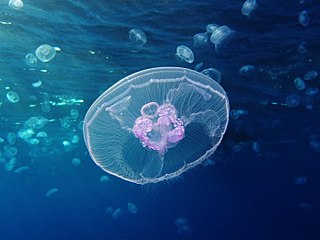
Krill(Euphausiids), are small and exclusively marine crustaceans of the order Euphausiacea, found in all the world's oceans. The name "krill" comes from the Norwegian word krill, meaning "small fry of fish", which is also often attributed to species of fish.

Aurelia aurita is a species of the family Ulmaridae. All species in the genus are very similar, and it is difficult to identify Aurelia medusae without genetic sampling; most of what follows applies equally to all species of the genus.

Myxobolidae is a family of myxosporean parasites which typically infect freshwater fishes, and includes the economically significant species, Myxobolus cerebralis. They have been shown to have a complex life cycle, involving an alternate stage in an invertebrate, typically an annelid or polychaete worm.

The oligotrichs are a group of ciliates, included among the spirotrichs. They have prominent oral cilia, which are arranged as a collar and lapel, in contrast to the choreotrichs where they form a complete circle. The body cilia are reduced to a girdle and ventral cilia. In Halteria and its relatives, they form bristles or cirri; however these forms may be closer relatives of the stichotrichs than of other oligotrichs. These organisms are very common in plankton communities, especially in marine systems. Usually found in concentrations of about 1 per ml, they are the most important herbivores in the sea, the first link in the food chain.
Hematodinium perezi is a pathogenic dinoflagellate parasite that infects crustaceans, including the Blue Crab and Norway Lobster and has been observed to have a significant impact on crustacean fisheries. Infected crustaceans frequently show signs of weakness and lethargy, and often die due to stress-related handling from fishing as well as metabolic exhaustion due to reduced feeding. This parasite is known to be quite transmissible between various crustacean hosts.
Dermocystidium is a genus of cyst-forming, eukaryotic fish parasites, the causative agents of dermocystidiosis.
Hematodinium is a genus of dinoflagellates. Species in this genus, such as Hematodinium perezi, the type species, are internal parasites of the hemolymph of crustaceans such as the Atlantic blue crab and Norway lobster. Species in the genus are economically damaging to commercial crab fisheries, including causing bitter crab disease in the large Tanner or snow crab fisheries of the Bering Sea.
Urastoma cyprinae is a turbellarian that infects the gills of numerous species. It has been reported as free-living organism in marine mud and on algae. Urastoma cyprinae is reported as an opportunistic mantle inhabitant on the gills of various bivalve species, including the clams Tridacna maxima and Tridacna gigas, and the mussels Mytilus edulis and Mytilus galloprovincialis. They are also found throughout the gill surface of C. virginica and is attracted by mucus that coats the gills of oysters. However, the nature of the host-parasite relationship remains unknown.

Perkinsids are single-celled protists that live as intracellular parasites of a variety of other organisms. They are classified as the class Perkinsea within the monotypic phylum Perkinsozoa. It is part of the eukaryotic supergroup Alveolata, along with dinoflagellates, their closest relatives, and another parasitic group known as Apicomplexa. Perkinsids are found in aquatic environments, as parasites of dinoflagellates and various animals.
Orchitophrya stellarum is a species of single-celled marine ciliates, a member of the class Oligohymenophorea. It is found living freely in the north Atlantic and Pacific Oceans but is also parasitic, being found inside the gonads of starfish.

Colliniidae is a family of ciliates of the order Apostomatida.
Pseudocollinia is a genus of parasitoid ciliate of the Colliniidae family.
Pseudocollinia brintoni is a species of parasitoid ciliates of the Colliniidae family. P. brintoni infects a species of krill, Nyctiphanes simplex.
Collinia beringensis is a species of parasitoid ciliates of the Colliniidae family. It is an endoparasite of Thysanoessa inermis, a species of krill.

Collinia oregonensis is a species of parasitoid ciliates of the Colliniidae family. It is known to infect the krill Euphausia pacifica, Thysanoessa spinifera, and Thysanoessa gregaria off the coast of Oregon and Washington. It caused a mass mortality of E. pacifica in June 2001 at the base of Astoria Canyon.
Miamiensis avidus is a species of unicellular marine eukaryote that is a parasite of many different types of fish. It is one of several organisms known to cause the fish disease scuticociliatosis and is considered an economically significant pathogen of farmed fish. M. avidus is believed to be the cause of a 2017 die-off of fish and sharks in the San Francisco Bay.

Philasterides dicentrarchi is a marine protozoan ciliate that was first identified in 1995 after being isolated from infected European sea bass reared in France. The species was also identified as the causative agent of outbreaks of scuticociliatosis that occurred between summer 1999 and spring 2000 in turbot cultivated in the Atlantic Ocean. Infections caused by P. dicentrarchi have since been observed in turbot reared in both open flow and recirculating production systems. In addition, the ciliate has also been reported to cause infections in other flatfishes, such as the olive flounder in Korea and the fine flounder in Peru, as well as in seadragons, seahorses, and several species of sharks in other parts of the world.
Scuticociliatosis is a severe and often fatal parasitic infection of several groups of marine organisms. Species known to be susceptible include a broad range of teleosts, seahorses, sharks, and some crustaceans. The disease can be caused by any one of about 20 distinct species of unicellular eukaryotes known as scuticociliates, which are free-living marine microorganisms that are opportunistic or facultative parasites. Scuticociliatosis has been described in the wild, in captive animals in aquariums, and in aquaculture. It is best studied in fish species that are commonly farmed, in which typical effects of infection include skin ulceration, hemorrhage, and necrosis, with post-mortem examination identifying ciliates in the skin, gills, blood, and internal organs including the brain.
Philasterides is a genus of ciliates in the order Philasteridae.
Hennegoides is a genus of cnidarian that is part of the family Myxobolidae.







